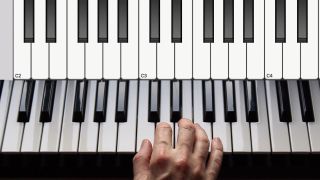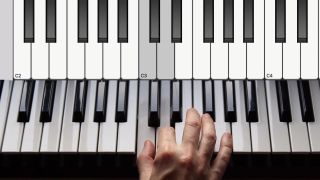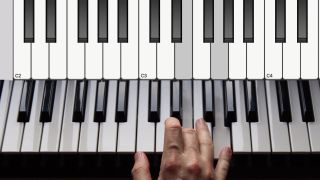How to develop finger independence on a keyboard
With two hands and ten fingers to consider, learning to play keyboards requires a great deal of dexterity. This exercise will help you develop yours.
To grow as a keyboard player, you need to get your hands used to doing different things at the same time, and your fingers as well. This is known as ‘independence’, and while learning almost all musical instruments involves developing it to a certain degree, the piano uses all ten fingers on both hands, not to mention the feet to a lesser extent.
Here's a simple exercise for the aspiring pianist, aimed at improving independence. It might seem a bit like hard work, but the results will speak for themselves, as your ham-fisted hammering turns into soaring musical flow.
For more keyboard playing advice, get the May 2018 edition of Computer Music.

Step 1: Remember the beginner’s exercise where we walked through the notes C-D-E-F-G-F-E-D-C? To help develop finger independence, we’re going to revisit this, but with a twist. First, assume the position shown above.

Step 2: The idea is to hold down a different note each time and play through the notes that surround it, without lifting off the held-down note. Sounds easy, but it’s actually pretty tricky, and is a great exercise for developing finger independence. Start by playing the C and D together with your thumb and index finger. Easy enough so far…

Step 3: Keep holding your thumb down on the C key, but lift off the D and play the E with your middle finger, followed by the F with your ring finger and G with your pinky - holding C down with your thumb the whole time. Then walk back down again from G through F, E and D without lifting your thumb, so that the C note sustains throughout.

Step 4: Play through this sequence four times or so, then play the C and D together once again, only this time lift your thumb off C while keeping D held down with your index finger. Play the notes either side of D in a smooth up/down sequence once more, this time skipping the held-down D note and playing C-E-F-G-F-E-C, keeping that index finger held down.
Get the MusicRadar Newsletter
Want all the hottest music and gear news, reviews, deals, features and more, direct to your inbox? Sign up here.

Step 5: Continue moving on through the other fingers, holding down E and playing around that, then F and playing around that, and so on. It’s much harder than it looks, and it doesn’t sound very nice while you’re playing it, but stick at it. Keep it slow at first, and eventually you’ll train your finger muscles and motor response accordingly.
Computer Music magazine is the world’s best selling publication dedicated solely to making great music with your Mac or PC computer. Each issue it brings its lucky readers the best in cutting-edge tutorials, need-to-know, expert software reviews and even all the tools you actually need to make great music today, courtesy of our legendary CM Plugin Suite.

MusicRadar deals of the week: Score over £400 off PRS and Epiphone guitars, $100 off Yamaha and Roland pianos, and so much more

“For those who think they know Joel’s story, as well as those who are not as familiar, I believe this two-part film is both a revelation and a surprise”: New Billy Joel doc is on the way











